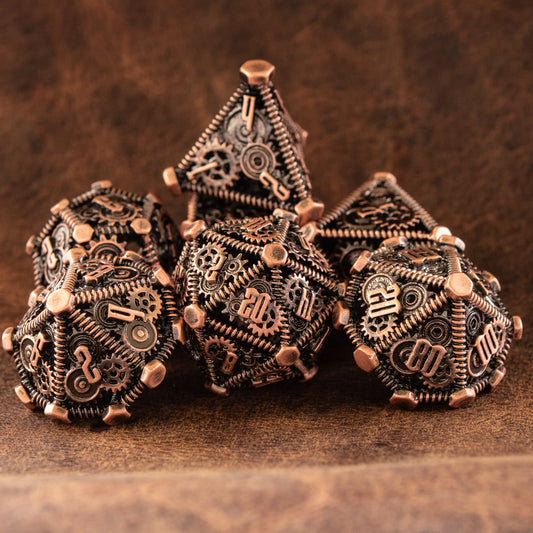What Are DND Dice Made Of
Share
What Are DND Dice Made Of?
Dungeons & Dragons (D&D) has captivated the hearts of millions of players worldwide, with its intricate storytelling, strategic gameplay, and the ever-important roll of the dice. These polyhedral dice are more than just tools for determining fate; they are iconic symbols of the game itself. But what exactly are D&D dice made of? In this comprehensive guide, we delve into the various materials used to craft these essential gaming components, exploring their characteristics, benefits, and impact on gameplay.
The Polyhedral Family
At the core of D&D is a set of polyhedral dice, each with a unique shape and purpose. A standard set includes the following:
- D4 (four-sided die)
- D6 (six-sided die)
- D8 (eight-sided die)
- D10 (ten-sided die)
- D12 (twelve-sided die)
- D20 (twenty-sided die)
- Percentile dice (two ten-sided dice, one numbered 00-90 and the other 0-9)
These dice are crafted from a variety of materials, each bringing its own unique attributes to the table.
Plastic Dice
Acrylic Dice
Acrylic dice are among the most popular choices for D&D players. They are affordable, durable, and come in a wide range of colors and designs. Acrylic is a type of thermoplastic that becomes pliable when heated, allowing for versatile shaping and intricate designs.
Pros:
- Affordable and widely available
- Durable and resistant to wear and tear
- Available in numerous colors and styles
Cons:
- May lack the premium feel of other materials
- Potential for imperfections if manufactured poorly
Resin Dice
Resin dice are known for their sharp edges and vibrant designs. They are crafted by curing and hardening resin through a chemical reaction, resulting in a solid, durable product. Resin allows for intricate patterns and often features translucent or layered effects that are visually stunning.
Pros:
- Sharp edges for precise rolls
- Vibrant and intricate designs
- Durable and long-lasting
Cons:
- Potential for air bubbles during manufacturing
- Generally more expensive than acrylic dice
Metal Dice
Metal dice have surged in popularity due to their distinct aesthetic and hefty feel. Most metal dice are made from zinc alloy, though aluminum and brass are also common. These materials offer durability and a premium feel that many players appreciate.
Pros:
- Satisfying weight and feel
- Durable and long-lasting
- Distinct aesthetic appeal
Cons:
- More expensive than plastic dice
- Can damage gaming surfaces if not used with a dice tray
- Not suitable for all players, especially children
Glass Dice
Glass dice, though delicate in appearance, are surprisingly resilient when handled with care. They offer a premium rolling experience and are often chosen for their visual appeal.
Pros:
- Visually stunning and unique
- Provide a premium feel
- Durable when handled properly
Cons:
- More expensive than plastic and metal dice
- Fragile and require careful handling
Gemstone Dice
Gemstone dice are crafted from genuine gemstones such as quartz, amethyst, and lapis lazuli. These dice are highly coveted for their natural beauty and unique properties.
Pros:
- Exquisite aesthetics and unique designs
- Durable and long-lasting
- Each set is unique due to natural variations in the stones
Cons:
- Among the most expensive dice options
- Can be fragile and require careful handling
Wooden Dice
Wooden dice are crafted from various types of wood, each imparting its own distinct characteristics. Common woods used include cherry, acacia, mahogany, and walnut.
Pros:
- Natural and earthy aesthetic
- Lightweight and portable
- Each set is unique due to natural variations in the wood grain
Cons:
- Less durable than metal or plastic dice
- Can be more expensive depending on the wood used
Bone Dice
Bone dice are crafted from animal bones or antlers, offering a distinct texture and appearance. These dice hold a special allure for players who appreciate the natural beauty of organic materials.
Pros:
- Unique and natural appearance
- Durable and long-lasting
- Offers a tactile and historical connection to ancient gaming traditions
Cons:
- Can be expensive
- Ethical considerations for some players
Liquid Core Dice
Liquid core dice contain a liquid-filled chamber that adds a mesmerizing visual effect when rolled. These dice are a novel and exciting addition to any collection.
Pros:
- Visually captivating and unique
- Provide a novel rolling experience
- Durable and long-lasting
Cons:
- More expensive than standard plastic dice
- Potential for leakage if not well-manufactured
Bakelite Dice
Bakelite, one of the first synthetic polymers, was widely used in the early to mid-20th century. Bakelite dice maintain a special place in the world of tabletop gaming due to their historical significance.
Pros:
- Historically significant and collectible
- Durable and long-lasting
- Unique vintage aesthetic
Cons:
- Less common in modern dice manufacturing
- Can be expensive and hard to find
LED Illuminated Dice
LED illuminated dice are a modern innovation, adding a touch of spectacle to the gaming table. These dice feature built-in LED lights that illuminate when rolled, enhancing the overall immersion and excitement of the game.
Pros:
- Visually spectacular and unique
- Enhance the gaming experience with lighting effects
- Durable and long-lasting
Cons:
- More expensive than standard dice
- Require batteries or charging
Choosing the Best Material for D&D Dice
Selecting the best material for your D&D dice ultimately depends on personal preferences and gameplay needs. Here are some factors to consider:
- Affordability: Plastic dice, particularly acrylic, are the most budget-friendly option.
- Durability: Metal and gemstone dice are highly durable, though they come with a higher price tag.
- Aesthetics: For a visually stunning set, consider gemstone, glass, or resin dice.
- Weight and Feel: Metal dice offer a satisfying heft, while plastic and wooden dice are lighter.
- Unique Designs: Resin, gemstone, and liquid core dice often feature intricate and unique designs.
Explore various materials to find the perfect set that aligns with your gaming style and preferences. Whether you prefer the affordability and variety of plastic dice, the weight and durability of metal dice, or the unique beauty of gemstone or glass dice, there is a set out there for every D&D enthusiast.
Storage and Maintenance
Proper storage and maintenance are essential to preserving the condition of your dice. Here are some tips:
- Storage: Use dice bags, boxes, or trays to keep your dice organized and protected.
- Cleaning: Clean your dice with a soft cloth and warm soapy water. For metal dice, use isopropyl alcohol to remove any residue.
- Handling: Handle delicate dice, such as glass and gemstone, with care to prevent damage.
Understanding what D&D dice are made of can help you choose the perfect set for your gaming style. Whether you prefer the classic feel of acrylic, the visual splendor of gemstone, or the unique effect of liquid core dice, the material of your dice can enhance your D&D experience.

